“Caliber” is a word people often use and misuse when talking about guns. “Handgun Calibers” even more so.
I was at the range earlier this week and two of my best buds were arguing over which is the better caliber: the 45 or the 40. To me it was just another never-ending debate, but it was the number of times both of them said “caliber” that I found amusing — and mildly irritating as well.
Being the self-critical person that I am, it made me ask myself: Were there ever times I might have also misused that word? And are there things about it I might not be aware of?
If you’re like me and you’re asking yourself the same questions, or if you’re new to firearms and you just want to expand your knowledge about handgun calibers in general, read on.
Table Of Contents
A Comprehensive Guide to Handgun Calibers
In this article, we aim to give you a comprehensive guide on handgun calibers. This means that we will explain about calibers and how they function, and then will provide some recommendations for you. You might be surprised at how little you know about this often used term.
Through this article, we plan to give you a comprehensive guide on understanding caliber, so that you can make the best decision for yourself in regard to purchasing a gun for yourself. Of course, the need for caliber does differ depending on the gun’s usage – whether it is law enforcement, concealed carry, personal defense, or more. The key is to look at your own needs, and to match them with a choice in our guide.
What Is a Caliber?
The Cambridge Dictionary defines “caliber” as either “the quality of someone or something, especially someone’s ability,” or “the width of the inside of a pipe, especially of the long cylinder-shaped part of a gun, or the width of a bullet”.
I can agree with the first definition, but being a firearms enthusiast, I think the second one has some inaccuracies.
Where it says “the long cylinder-shaped part of a gun”, I think we can all pretty much agree that it’s a gun’s barrel they were referring to, specifically the measurement of the bore.
Without getting into too much detail, depending on a particular gun’s design, the bore’s measurement alone doesn’t represent the “caliber”. Think semi-auto handguns, rifles and shotguns. The chamber and the barrel of any of these guns are formed from the same piece of steel, but the chamber has a different measurement compared to that of the bore.
Caliber is Not the Barrel
Since the chamber is most of the time a few hundredths of an inch wider than the bore and the chamber is part of that “long cylinder-shaped part of a gun”, that definition is inaccurate.
Where it says “the width of a bullet”, I think we can all pretty much agree again that it’s a bullet’s cylindrical portion the dictionary was referring to — but it didn’t make a clear distinction as to which portion of the bullet the “caliber” is a measure of.
The portion of the bullet that makes contact with the rifling grooves inside a barrel’s bore as it is propelled by burning gunpowder is, indeed, measured in inches or millimeters and is commonly referred to as “caliber”. But what of the bullet’s nose? Isn’t that also part of the caliber? Nope.
What is a Bullet’s Nose Called?
A bullet’s nose is called its “ogive”, and it is measured a different way (but we’ll not get into that). So again, The Cambridge Dictionary is inaccurate.
Before I got really into handguns, I remember some of the questions I would often ask myself:
- Does a38 beat a 9 because the number 38 is bigger than the number 9?
- Is the 357 more powerful than any other handgun caliber because it has three digits while most others only have two?
- If the 357 is more powerful than a 45, is it also more powerful than a 44?
- Why does the 44 have a Special and a Magnum when the 357 only has a Magnum and no Special?
- What’s with all the different suffixes after the numbers? What’s an ACP? What’s a WinMag? What’s a Super? What’s a Magnum? And why do some people call the 40 “short and weak” when they’re aware the S&W next to it means SmithWesson?
I admit, I used to be that dumb.
Handgun Calibers Comparison
To me, the word “caliber” as it pertains to firearms is a label — not just a measurement of a bullet or a bore’s dimensions —but a way to identify the intrinsic qualities of a cartridge that makes it unique.
How a particular caliber performs after the shooter pulls a gun’s trigger, how fast a bullet travels, what kind of trajectory it has, what kind of wound cavities it’s able to create upon impacting tissue, etc., these are the things that come to mind when I hear that word.
To flesh out all the details, I created a table that lists all of the most common (and not-so-common) handgun calibers and all pertinent info about them:
Handgun Calibers Chart/PDF
| Handgun Caliber | Bullet Diameter (inches) | Bullet Weight (grains) | Velocity (fps) | Muzzle Energy (ft.lbf) | Average price per round | Intended Purpose |
|---|---|---|---|---|---|---|
| .25 ACP | 0.251 | 50 | 949 | 100 | $0.64 | Plinking, Varmint |
| .22 LR | 0.223 | 40 | 1,070 | 102 | $0.09 | Plinking, Varmint |
| .22 WMR | 0.224 | 40 | 1,477 | 194 | $0.20 | Plinking, Varmint |
| .32 ACP | 0.312 | 60 | 1,231 | 202 | $1.16 | Plinking, Varmint |
| .32 H&R Magnum | 0.312 | 85 | 1,114 | 234 | $0.85 | Self-defense, Varmint |
| FN 5.7x28mm | 0.224 | 40 | 1,624 | 234 | $0.50 | Self-defense, Plinking |
| .17 HMR | 0.172 | 20 | 2,350 | 245 | $0.20 | Plinking, Varmint |
| .380 ACP | 0.355 | 95 | 1,175 | 291 | $0.24 | Self-defense, Plinking |
| .22 Hornet | 0.224 | 40 | 1.920 | 327 | $0.94 | Plinking, Varmint |
| .22 Remington Jet | 0.222 | 40 | 1,980 | 348 | $0.52 | Plinking, Varmint |
| .38 Special (+P) | 0.357 | 158 | 1,000 | 351 | $0.32 | Self-defense |
| .45 ACP | 0.451 | 230 | 900 | 414 | $0.25 | Self-defense |
| .38 Super | 0.356 | 115 | 1,300 | 431 | $0.29 | Self-defense |
| .40 S&W | 0.400 | 180 | 1,053 | 443 | $0.21 | Self-defense |
| 9x19mm Parabellum (+P) | 0.355 | 125 | 1,282 | 456 | $0.15 | Self-defense, Plinking |
| .50 GI | 0.500 | 275 | 875 | 467 | $1.50 | Self-defense |
| .400 Cor-Bon | 0.401 | 165 | 1,250 | 527 | $1.05 | Self-defense, Medium game |
| 9x23 Winchester | 0.356 | 125 | 1,450 | 583 | $0.90 | Self-defense, Medium game |
| .327 Federal Magnum | 0.312 | 115 | 1,535 | 602 | $1.19 | Self-defense |
| .450 SMC | 0.451 | 230 | 1,130 | 652 | $0.95 | Self-defense, Medium game |
| .357 SIG | 0.355 | 125 | 1,537 | 656 | $0.99 | Self-defense |
| .45 Super | 0.451 | 230 | 1,149 | 674 | $0.91 | Self-defense |
| .22 TCM | 0.224 | 40 | 2,777 | 685 | $0.42 | Self-defense, Varmint |
| .44 Special (+P) | 0.4325 | 250 | 1,125 | 702 | $1.55 | Self-defense, Medium game |
| 10mm | 0.400 | 180 | 1,350 | 728 | $0.40 | Self-defense, Medium game |
| .357 Magnum | 0.357 | 158 | 1,450 | 737 | $0.25 | Self-defense, Medium game |
| 9x25 Dillon | 0.356 | 147 | 1,520 | 754 | $1.10 | Self-defense, Medium game |
| 460 Rowland | 0.451 | 230 | 1,300 | 863 | $1.55 | Self-defense, Medium game |
| .41 Magnum | 0.410 | 210 | 1,363 | 866 | $1.42 | Medium game |
| .40 Super | 0.400 | 200 | 1,400 | 870 | $1.45 | Self-defense, Medium game |
| .44 AMP | 0.429 | 200 | 1,485 | 979 | $3.13 | Large game |
| .357 Maximum | 0.357 | 180 | 1,600 | 1,023 | $1.12 | Large game |
| .45 Win Mag | 0.452 | 260 | 1,345 | 1,044 | $1.65 | Large game |
| .414 Supermag | 0.410 | 210 | 1,500 | 1,049 | $1.75 | Large game |
| .45 Long Colt (+P) | 0.454 | 300 | 1,325 | 1,169 | $1.50 | Self-defense, Large game |
| .44 Magnum | 0.429 | 250 | 1,550 | 1,333 | $1.60 | Large game |
| .475 Wildey Magnum | 0.475 | 250 | 1,611 | 1,440 | $3.00 | Large game |
| .480 Ruger | 0.475 | 275 | 1,601 | 1,565 | $1.50 | Large game |
| .50 AE | 0.500 | 325 | 1,473 | 1,566 | $1.50 | Large game |
| .500 Linebaugh | 0.510 | 435 | 1,300 | 1,632 | $3.00 | Large game |
| .44 Mad Max | 0.429 | 315 | 1,550 | 1,680 | $2.00 | Large game |
| .440 Cor-Bon | 0.429 | 240 | 1,800 | 1,726 | $2.25 | Large game |
| .475 Linebaugh | 0.475 | 400 | 1,400 | 1,741 | $2.70 | Large game |
| .445 Supermag | 0.429 | 310 | 1,601 | 1,764 | $2.00 | Large game |
| .500 JRH | 0.500 | 425 | 1,450 | 1,984 | $2.70 | Large game |
| .500 Wyoming Express | 0.500 | 440 | 1,450 | 2,054 | $2.20 | Large game |
| .454 Casul | 0.454 | 300 | 1,780 | 2,110 | $2.00 | Large game |
| .475 Linebaugh Maximum | 0.475 | 400 | 1,550 | 2,133 | unavailable online | Large game |
| .500 Linebaugh Maximum | 0.500 | 450 | 1,550 | 2,400 | unavailable online | Large game |
| .460 S&W Magnum | 0.452 | 300 | 2,080 | 2,881 | $2.35 | Large game |
| .500 S&W Magnum | 0.500 | 450 | 1,707 | 2,911 | $2.50 | Large game |
It’s by no means a complete list, as I’m only including available info online for a total of 52 different handgun calibers, 23 of which are cartridges for semi-autos, 25 are for revolvers and the remaining two wildcards (not wildcats), namely the .22 LR and .22 WMR, are kind of all over the place because they can be chambered in rifles, revolvers, and semi-autos.
Handgun Caliber Categories
To make the comparisons easier, we’re categorizing handgun calibers based on their launching platforms i.e. semi-auto handguns and revolvers; and on their intended purpose: whether they’re only for plinking, self-defense, hunting or combinations thereof.
It helps to look at the category of calibers based on their intended use because it allows you to visualize it based on how you want to use the gun. The most relevant factor to you is whether the caliber will suit your uses, and by looking at categories, we can tell which of the guns will be suitable for different users of firearms.
Handgun Caliber SUB-CATEGORIES
Handgun calibers for hunting will be further divided into three sub-categories: varmint, medium game, and large game.
After every handgun caliber has been placed in its respective category, we’ll compare all of them based on their relative strengths and weaknesses in these three key areas:
- Bullet velocity (the higher a bullet’s velocity, the flatter its trajectory and the longer its effective range);
- Muzzle energy (the higher a bullet’s muzzle energy, the more powerful it is);
- Price (the lower the price, the more popular the handguns and ammo for a particular caliber and the better its availability);
HANDGUN CALIBER METRICS FOR ANALYSIS
I was initially going to include other metrics like stopping power (for self defense rounds), one-hit-kill potential (for hunting rounds), accuracy, terminal performance and recoil to compare all listed handgun calibers against each other but decided against it because of the following reasons:
HANDGUN CALIBER STOPPING POWER
Stopping power and one-hit-kill potential in my opinion (and lot of other sensible gun nuts’) cannot be quantified for a lot of reasons. These are highly debated issues and can be very large topics in and of themselves so I won’t use these metrics.
Suffice it to say not every target hit by a specific bullet center of mass will react the same way: humans have different stature and varying levels of willpower, and bad guys high on meth, regardless of physiological and psychological limitations, will be even harder to take down.
Game animals on the other hand, well there are just too many species to compare. We will not be covering that topic in this analysis.
Theoretically, anyone can place well-aimed heart and head shots in their target given ample time and practice. Granted it’s easier said than done, but guns don’t shoot without someone pulling the trigger, so it’s only right to put the operator in the equation when determining stopping power, one-hit-kill potential and accuracy.
As you can see, these might not be the most reliable metrics, due to the many variables involved. It is really best to focus on the individual power of each gun, as that is more of a constant thing. Focusing exclusively on stopping power will yield too many variables to have a reliable metric.
ACCURACY
A bullet is accurate if it can consistently hit a target at point of aim over a given distance assuming the shooter knows what he’s doing.
Sounds pretty straightforward, but accuracy also depends on a lot of other variables outside of the shooter’s marksmanship skills.
Some bullet shapes and designs have a higher ballistic coefficient, making them much more accurate than others. Ballistic coefficient has little to do with just a bullet’s diameter, it’s a function of a bullet’s overall dimensions.
Sights Make Accuracy
The type of sights on a firearm also have a direct influence on accuracy. Reflex sights and red dot sights are great for faster target acquisition but are expensive. Scopes are real accurate for long range shots but rendered useless for bullets with poor ballistic coefficient.
Almost all handguns and revolvers come with either adjustable or fixed iron sights. Whether or not these sights are zeroed properly will greatly affect accuracy as well.
And lastly, barrel rifling stabilizes a bullet by making it spin as it exits the barrel.
Not to complicate this topic, but there are two types of barrel rifling — lands-and-grooves and polygonal, and the number of rifling grooves (in the case of the former) or rifling surfaces (in the case of the latter) affects how fast a bullet would spin, thereby also affecting accuracy.
Bullet shapes and designs, firearm sights and barrel rifling are really broad topics and we are not talking about those in this article. Ergo accuracy as a metric will not be used.
As you can see, many things will effect an accuracy besides just common calibers of guns. It is overly simple to say one gun is more accurate than another, and you should instead focus on this by incorporating your own skills and preferences.
TERMINAL PERFORMANCE
A bullet’s terminal performance is measured by how deep it penetrates a given target and what kind of wound cavities it can create.
Terminal performance is largely determined by two things: muzzle energy (which is a function of bullet weight, powder charge and barrel length) and bullet design (a function of price).
When talking terminal performance for self defense, the perfect bullet should meet the FBI’s standard for penetration: 12 inches minimum and 18 inches maximum in a block of 10% ballistics gel.
A Lehigh Defense Xtreme Penetrator .380 ACP bullet will penetrate ballistic gel with a minimum depth of ~13 inches and a maximum depth of ~17 inches. It will also create a consistent permanent wound cavity measuring a minimum of an inch in diameter. So what’s the kicker?
The .380 ACP is considered a weak round.
Yet with a fluted bullet design it can go toe to toe against its bigger brother, the 9mm (FMJ) and even surpass the .45 ACP (JHP) in terms of penetration and wounding capability. But there’s a catch — these new fluted bullet designs can be really expensive.
Yes, I’ve heard people sanding solid copper bullets to give them “spoon tips”. I don’t like messing with bullets so I have no personal experience with spoon tips.
I wouldn’t recommend using those (unless they came out of a factory, e.g. the spoon tips for the 7.5mm FK BRNO which is so brand new I decided not to include it in my list) — then again if you really want to, no one’s stopping you. You’ve been warned.
But I digress. As far as terminal performance is concerned, when comparing handgun calibers within the same category, bullet design trumps muzzle energy. And there are simply a lot of popular bullet designs out there which is a topic for another day.
Since this article is about handgun calibers, we will not be talking about bullet designs, which is why we are not using terminal performance as a metric.
Handgun Caliber RECOIL
Recoil depends on a few variables, two of which are outside the scope of this analysis: the weight of the handgun (polymer handguns will have more recoil compared to all-steel semi-autos and revolvers) and the platform design (an all-steel semi-auto will always have less felt recoil compared to an all-steel revolver of the same size by virtue of the recoil spring within its slide assembly).
Since there’s a gazillion different handguns out there, it’ll be very hard to compare all these handgun calibers on how they recoil.
Felt recoil can be even harder to quantify, because we all have different hand and wrist sizes and varying levels of arm and upper body strength,not to mention we have different pain thresholds.
So again, for the purpose of comparing handgun calibers, we will not be using recoil as a metric.
SEMI-AUTO HANDGUN CALIBERS CHART
| Semi-Auto Handgun Caliber | Bullet Diameter (inches) | Bullet Weight (grains) | Velocity (fps) | Muzzle Energy (ft.lbf) | Average price per round | Intended Purpose |
|---|---|---|---|---|---|---|
| .25 ACP | 0.251 | 50 | 949 | 100 | $0.64 | Plinking, Varmint |
| .22 LR | 0.223 | 40 | 1,070 | 102 | $0.09 | Plinking, Varmint |
| .22 WMR | 0.224 | 40 | 1,477 | 194 | $0.20 | Plinking, Varmint |
| .32 ACP | 0.312 | 60 | 1,231 | 202 | $1.16 | Plinking, Varmint |
| FN 5.7x28mm | 0.224 | 40 | 1,624 | 234 | $0.50 | Self-defense, Plinking |
| .380 ACP | 0.355 | 95 | 1,175 | 291 | $0.24 | Self-defense, Plinking |
| .45 ACP | 0.451 | 230 | 900 | 414 | $0.25 | Self-defense |
| .38 Super | 0.356 | 115 | 1,300 | 431 | $0.29 | Self-defense |
| .40 S&W | 0.400 | 180 | 1,053 | 443 | $0.21 | Self-defense |
| 9x19mm Parabellum (+P) | 0.355 | 125 | 1,282 | 456 | $0.15 | Self-defense, Plinking |
| .50 GI | 0.500 | 275 | 875 | 467 | $1.50 | Self-defense |
| .400 Cor-Bon | 0.401 | 165 | 1,250 | 527 | $1.05 | Self-defense, Medium game |
| 9x23 Winchester | 0.356 | 125 | 1,450 | 583 | $0.90 | Self-defense, Medium game |
| .450 SMC | 0.451 | 230 | 1,130 | 652 | $0.95 | Self-defense, Medium game |
| .357 SIG | 0.355 | 125 | 1,537 | 656 | $0.99 | Self-defense |
| .45 Super | 0.451 | 230 | 1,149 | 674 | $0.91 | Self-defense |
| .22 TCM | 0.224 | 40 | 2,777 | 685 | $0.42 | Self-defense, Varmint |
| 10mm | 0.400 | 180 | 1,350 | 728 | $0.40 | Self-defense, Medium game |
| 9x25 Dillon | 0.356 | 147 | 1,520 | 754 | $1.10 | Self-defense, Medium game |
| 460 Rowland | 0.451 | 230 | 1,300 | 863 | $1.55 | Self-defense, Medium game |
| .40 Super | 0.400 | 200 | 1,400 | 870 | $1.45 | Self-defense, Medium game |
| .45 Win Mag | 0.452 | 260 | 1,345 | 1,044 | $1.65 | Large game |
| .475 Wildey Magnum | 0.475 | 250 | 1,611 | 1,440 | $3.00 | Large game |
| .50 AE | 0.500 | 325 | 1,473 | 1,566 | $1.50 | Large game |
| .440 Cor-Bon | 0.429 | 240 | 1,800 | 1,726 | $2.25 | Large game |
A note on this list.
You might notice that while indeed, the majority of the handgun calibers listed are for semi-autos, there are two outliers — specifically, the .22 LR and the .22 WMR.
As mentioned earlier,both those rounds are actually rifle calibers.
But since there is more than a handful of semi-auto handguns and revolvers chambered for those rounds, we decided to include them in this list.
In general, semi-auto handguns can only use rimless cartridges because rimmed cartridges are difficult to stack in box-type magazines. However, we are aware of obscure designs that allow for certain revolver cartridges to chamber in some semi-auto handguns (e.g. Coonan, LAR Grizzly and Desert Eagle in .357 Magnum and some Wildeys, AutoMags and again the Desert Eagle chambered in .44 Magnum).
To make the comparisons simpler, we decided not to include any revolver cartridges in this list.
SEMI-AUTO HANDGUN CALIBERS FOR PLINKING
The only thing that should concern anyone when choosing a semi-auto handgun caliber just for plinking is price. The cheaper the ammo, the more bang for your buck (literally).
The graph above shows that the .22 LR is THE MOST affordable plinking round for any semi-auto handgun at $0.09 per round.
It is trailed closely by the 9mmat $0.35, while its bigger rimmed brother the .22 WMR (Winchester Magnum Rimfire — or .22 Magnum) comes in third at double the .22 LR’s price.
SEMI-AUTO CALIBERS FOR SELF DEFENSE
Now we get into the meat of our semi-auto handgun caliber discussion. Compared to revolvers, semi-autos as a launching platform are almost always going to be the better picks when considering getting concealable firearms for self defense.
Our semi-auto handgun caliber lists a total of 17 different cartridges for just this purpose. That is 17 out of the 52 handgun calibers on our list which comprises the majority of semi-auto cartridges in this analysis.
If you don’t have a semi-auto handgun as a CCW and you’re trying to decide which among the most popular self defense rounds you should choose, always consider price (even if you’re too damn rich) because it affects two things:
- One, handgun options availability (the more competitive a round commercially, the more handguns are built for it, and the more handguns on the market, the better aftermarket support);
- Two, how often you’ll get to spend time in the range for practice.
SELF DEFENSE SEMI-AUTO CALIBERS — PRICING
From the graph above, we can see that the 9mm is the cheapest at $0.15 a pop, followed closely by the .40 S&W at $0.21, the .380 ACP at $0.24, the .45 ACP at $0.25, and the .38 Super at $0.29. This shouldn’t really come as a surprise.
SELF DEFENSE SEMI-AUTO CALIBERS – MUZZLE ENERGY
A higher muzzle energy equates to overall better terminal performance, but more power isn’t always better, as we discussed on this thread. If for nothing else, a bullet with too much muzzle energy will be more difficult to shoot accurately and rapidly.
All the handgun calibers listed on the graph above will be adequate for self defense, we’re only comparing them on their muzzle energies to try and differentiate them from each other.
At $0.15 per round and with good ballistic performance, the 9mm simply stands out. It is closely trailed by the .40 S&W, the .45 ACP and the .38 Super. And we can’t dismiss the merits of the .380 ACP — it deserves some kind of recognition if only for the fact that some of the smallest handguns on the market are chambered for it (if you need more info you can check out this thread).
If you want the latest and quite possibly the greatest for CCW, consider the .22 TCM. It has low recoil, more muzzle energy than a .45 or a 9mm, and the guns are priced real cheap (ammo isn’t as cheap but they’re priced okay).
SEMI AUTO CALIBERS FOR VARMINT
What’s great for plinking is most of the time also great for hunting varmint.
The graph above shows the two .22 rimfire cartridges edging out their other two competitors when it comes to affordability. But if you’re shooting varmint from a hundred yards away, maybe you’ll need to check the velocity graph below:
The .22 Winchester Magnum Rimfire at $0.20 a pop is the fastest of the four semi-auto handgun varmint calibers. Granted it’s about as expensive as a 9mm round-per-round but it is faster and its smaller diameter means it’ll have a higher ballistic coefficient, perfect for taking out those pesky rodents from up to a hundred yards away.
SEMI-AUTO CALIBERS FOR MEDIUM GAME
The graph below has seven of what we think are the only semi-auto handgun calibers good for hunting up to deer-size game.
MEDIUM GAME SEMI-AUTO CALIBER — PRICING
The 10mm is the most affordable semi-auto handgun cartridge for medium game. Again, cheaper ammo means more practice, and more practice means more venison on the table for less. At $0.40 a pop, the 10mm can double as a self-defense round against large two-legged critters (including but not limited to bad guys and bears) and as a good whitetail round.
MEDIUM GAME SEMI-AUTO CALIBERS — BALLISTICS
Unlike how we compared semi-auto handgun calibers for self defense, for hunting, we are including velocity and muzzle energy as two very important key metrics. This is because of the longer distances where a hunter must take a shot (as opposed to 5- to 10-yards in typical self defense situations).
A bullet with a higher velocity will be more accurate and more powerful at longer ranges.
The9×25 Dillontakes the lead in the velocity department (highest orange bar, third from left) when comparing semi-auto handgun calibers intended for hunting medium game, which is not surprising — it’s like the.357 SIG on steroids.

As far as muzzle energy, the .40 Super is the top dog, but availability issues have been hounding this cartridge since the company that manufactured it went out of business. If you don’t already have a .40 Super handgun, don’t bother buying one.
The 460 Rowland, another similar powerhouse of a wildcat, is just a hair short of muzzle energy but it’s the most expensive medium game cartridge.
SEMI-AUTO CALIBERS FOR LARGE GAME
We only have five semi-auto handgun calibers on our list for hunting large game. The graph below compares them on per-round cost.
LARGE GAME SEMI-AUTO CALIBERS — PRICING
Being the eternal cheapskate that I am, even if the .50 AE costs only $1.50 per round, I wouldn’t buy a Desert Eagle to hunt large game. There are infinitely better hunting rifle options and if I wanted to hunt with a handgun, I’d really just opt for a big-bore revolver.
Still, if money isn’t an issue and you’re considering buying (or if you just happen to own) a Desert Eagle chambered in .50 AE, you’d be pleased to know that its 50-caliber round is the most affordable semi-auto handgun caliber for hunting large game.
All the other calibers on the graph above are close to obsolescence if they’re not already obsolete — except maybe for the .44 AMP (Automag Pistol).
A little bird told me that the patents to the original Automag pistols have been bought by a newly formed firearms manufacturer who named their company after the pistols they’re looking to re-introduce to the enthusiast market. If the newer Automag pistols turn out to be cheaper than Deagles I’d gladly get one for bear.
LARGE GAME SEMI-AUTO CALIBERS — BALLISTICS
The.440 Cor-Bondwarfs all the other big-bore semi-auto handgun calibers on this list when it comes to sheer power and speed. Again, not surprising considering how and why the round was developed.
Like all necked-down cartridges, it sacrifices a bit of bullet weight and cross sectional density to gain blistering speeds, albeit in this case, it does it rather superfluously to the point that it didn’t catch on in popularity, forcing Cor-Bon/Glaser LLC to stop manufacturing the rounds due to low demand.
Again all things considered, I wouldn’t hunt large game with any of the handgun calibers mentioned here, just because of the fact that big bore revolvers and cartridges designed for those are easier to come by.
REVOLVER CALIBERS LIST
| Revolver Caliber | Bullet Diameter (inches) | Bullet Weight (grains) | Velocity (fps) | Muzzle Energy (ft.lbf) | Average price per round | Intended Purpose |
|---|---|---|---|---|---|---|
| .22 LR | 0.223 | 40 | 1,070 | 102 | $0.09 | Plinking, Varmint |
| .22 WMR | 0.224 | 40 | 1,477 | 194 | $0.20 | Plinking, Varmint |
| .32 H&R Magnum | 0.312 | 85 | 1,114 | 234 | $0.85 | Self-defense, Varmint |
| .17 HMR | 0.172 | 20 | 2,350 | 245 | $0.20 | Plinking, Varmint |
| .22 Hornet | 0.224 | 40 | 1.920 | 327 | $0.94 | Plinking, Varmint |
| .22 Remington Jet | 0.222 | 40 | 1,980 | 348 | $0.52 | Plinking, Varmint |
| .38 Special (+P) | 0.357 | 158 | 1,000 | 351 | $0.32 | Self-defense |
| .327 Federal Magnum | 0.312 | 115 | 1,535 | 602 | $1.19 | Self-defense |
| .44 Special (+P) | 0.4325 | 250 | 1,125 | 702 | $1.55 | Self-defense, Medium game |
| .357 Magnum | 0.357 | 158 | 1,450 | 737 | $0.25 | Self-defense, Medium game |
| .41 Magnum | 0.410 | 210 | 1,363 | 866 | $1.42 | Medium game |
| .357 Maximum | 0.357 | 180 | 1,600 | 1,023 | $1.12 | Large game |
| .414 Supermag | 0.410 | 210 | 1,500 | 1,049 | $1.75 | Large game |
| .45 Long Colt (+P) | 0.454 | 300 | 1,325 | 1,169 | $1.50 | Self-defense, Large game |
| .44 Magnum | 0.429 | 250 | 1,550 | 1,333 | $1.60 | Large game |
| .480 Ruger | 0.475 | 275 | 1,601 | 1,565 | $1.50 | Large game |
| .500 Linebaugh | 0.510 | 435 | 1,300 | 1,632 | $3.00 | Large game |
| .44 Mad Max | 0.429 | 315 | 1,550 | 1,680 | $2.00 | Large game |
| .475 Linebaugh | 0.475 | 400 | 1,400 | 1,741 | $2.70 | Large game |
| .445 Supermag | 0.429 | 310 | 1,601 | 1,764 | $2.00 | Large game |
| .500 JRH | 0.500 | 425 | 1,450 | 1,984 | $2.70 | Large game |
| .500 Wyoming Express | 0.500 | 440 | 1,450 | 2,054 | $2.20 | Large game |
| .454 Casull | 0.454 | 300 | 1,780 | 2,110 | $2.00 | Large game |
| .475 Linebaugh Maximum | 0.475 | 400 | 1,550 | 2,133 | unavailable online | Large game |
| .500 Linebaugh Maximum | 0.500 | 450 | 1,550 | 2,400 | unavailable online | Large game |
| .460 S&W Magnum | 0.452 | 300 | 2,080 | 2,881 | $2.35 | Large game |
| .500 S&W Magnum | 0.500 | 450 | 1,707 | 2,911 | $2.50 | Large game |
A note on this list as well.
Just as we didn’t include revolver rounds in the semi-auto handgun calibers list, we did the same here. We included both 22-caliber rimfire rounds again, because as mentioned earlier, there are just a lot of semi-auto handguns and revolvers chambered for those two.
While in general, revolvers can only accept rimmed cartridges, some revolvers have a cylinder recess for moon clips out of the box, and moon clips allow for rimless cartridges to be chambered in appropriate-caliber revolvers.
Some revolver enthusiasts have their revolver’s cylinder reamed by competent gunsmiths to allow for moon clips. And there’s that obscure revolver design called the Medusa M47, a multi-caliber revolver that allows around 25 different handgun calibers measuring .35 inches in diameter to be chambered in it.
Again, to make things simpler, we are not including any semi-auto handgun calibers in this list.
REVOLVER CALIBERS FOR PLINKING
As with semi-auto plinking calibers, we only want to consider price when shopping around for revolver plinking rounds.
The .22 LR is still the undisputed king of plinking rounds at $0.09 a pop.
It doesn’t matter if you’re into semi-autos or revolvers, you really have to have a gun chambered in .22 LR if you want extended hours of plinking fun.
REVOLVER CALIBERS FOR SELF DEFENSE
I know what you’re thinking. Why is the .357 Magnum the cheapest on the list?
SELF DEFENSE REVOLVER CALIBERS – PRICING
Well, it’s because of its popularity, due to the fact that it’s a proven manstopper and there are a huge lot of revolvers manufactured to chamber it.
The .38 Special standard pressure round will be cheaper but except for a very few misfits who carry old alloy revolvers, the majority of handgunners consider it pointless. I myself, being a revolver enthusiast, would feel kind of undergunned if I were to carry a .38 revolver loaded only with standard pressure rounds, which is why I decided to only include its +P variant in the list.
Round per round, the .38 Special +P isn’t that much more expensive compared to the .357 magnum, it’s only a $0.07 difference at most. What it has going for it is the fact that all .38 Special revolvers are lighter and relatively smaller compared to even the smallest revolvers in .357 like Ruger’s SP101, making them easier to carry concealed.
SELF DEFENSE REVOLVER CALIBERS — MUZZLE ENERGY
Again because of typical self-defense scenarios not requiring super-fast bullets (because the typical bad guy will only attack from a few yards away), we won’t have to look at velocities.
The graph above shows that the .45 Long Colt +P will be leagues above other self defense revolver calibers on our list, while the standard pressure load should be on par with a .45 ACP. If you carry a Taurus Judge or a S&W Governor, you made a good choice.
I personally wouldn’t want a revolver in .45 Long Colt though. Yes, the +P loads are powerful, but they’re also the most expensive revolver cartridgeon our list.
As a special mention, Ruger’s SP101 revolvers in .327 Federal Magnum holds six rounds while those chambered for .357 Magnum only holds five. These are some of the smallest all-steel magnum revolvers on the market. And the.327 Federal Magnum is no slouch, only around a hundred foot-pounds less powerful than a hot .357 Magnum load.
REVOLVER CALIBERS FOR VARMINT
As with varmint small caliber specifications for semi-auto handguns, the .22 LR is still the cheapest revolver round for hunting varmint. In fact, it could very well be the cheapest of all calibers whether we’re talking semi-autos, revolvers, or rifles. But let’s not belabor that point. Moving on…
Whereas with semi-auto handgun calibers, the only real contender for varmint is the .22 WMR, that is not the case with revolver calibers.
The .17 HMR bullet flying out of a revolver barrel at 2,350 feet per second is the fastest of all varmint calibers. It also happens to be the fastest bullet in our list bar none. And they’re also cheap at just $0.20 per round.
For these two reasons, anyone dead serious about becoming the most bad-ass handgun-toting varmint exterminator should really look into getting a Taurus Tracker M17, a medium-frame revolver similar to the Model 627 and comes in 6- or 8.5-inch heavy barrel.
REVOLVER CALIBERS FOR MEDIUM GAME
The revolver calibers below are the only three that I think will be great for hunting deer up to a hundred yards away. We also find these to be the best caliber for hunting wild boar.
MEDIUM GAME REVOLVER CALIBERS — PRICING
The graph below shows, again, that the venerable .357 Magnum being one of the cheapest revolver calibers on the market today is the go-to round for when you want to hunt deer and you don’t have a lot of buck to spend (pun not intended).
MEDIUM GAME REVOLVER CALIBERS — BALLISTICS
And looking at the ballistic performance graph below, the hottest .357 Magnum hunting loads are almost in the same energy category as the .41 Magnum, another magnum round that fills the gap between the .357 and the .44 magnums.
If you’ve never shot a long barrel magnum revolver before, you’re missing out on a lot.
We have a list of some of the best revolvers chambered for the .357 Magnum, you ought to check it out.
REVOLVER CALIBERS FOR LARGE GAME
The majority (17) of the handgun calibers on our list are semi-auto rounds for self defense.
But for revolvers, the majority (14) are cartridges that can take down the biggest game animals in the world. Why is that?
LARGE GAME REVOLVER CALIBERS — PRICING
A semi-auto handgun is great for self-defense because it has a thinner profile which makes it easier to be carried concealed. But the thicker revolver frame can withstand more punishment from the most powerful cartridges.
While there are quite a number of people who have taken down up to elk- and bear-size game with .357 Magnum rounds hot-loaded to Elmer Keith specs, the consensus among handgun hunting enthusiasts is it’s only going to be barely adequate.
This is why I decided not to include the .357 Magnum in our list of large game revolver calibers. Instead, the bare minimum I would recommend for big game is the .357 Maximum, a more powerful version of the .357 Magnum. At $1.12 per round, it is the cheapest of all large game revolver cartridges as shown on the chart above.
Unfortunately, there aren’t a lot of revolvers on the market today that can shoot this potent round. Ruger has some Blackhawks and there are a few Dan Wesson revolvers floating around for sale on the interwebz.
If you don’t already happen to own one of these .357 Maximum revolvers, then you’ll have to move up in the caliber spectrum. For just $1.60 a pop, .44 Magnum rounds will be your minimum bet if you want a powerful handgun for grizzly bear.
The Taurus Raging Bullin .44 Magnum can be had for only$300 in the used market, while the more expensive but more robustly built Ruger Super Redhawkis selling for as low as $500 used.
If you don’t mind spending more, consider the S&W 629 Performance Center Stealth Hunter model. It’ll cost around ~$1,000 but you get what you pay for.
LARGE GAME REVOLVER CALIBERS — BALLISTICS
We really can’t end this article without talking about what Smith and Wesson is touting as the most powerful production revolver on the market, the S&W 500 Magnum X-frame revolver.
Yes, it is THE most powerful production revolver which also makes it THE most powerful production handgun in the whole world, and Smith and Wesson wouldn’t make such a grand claim if their 50-caliber revolver chambers anything that isn’t the most powerful 50-caliber round on the market, the .500 S&W Magnum.
Focus on the gray bars on the chart below and you’ll see why.
Personally I think the .500 S&W Magnum is just too much power for even the largest game animals in the planet.

Granted, a smaller and lighter revolver will have significantly more recoil than a bigger and heavier one, but when you’re only a few meters away from a charging bear, recoil shouldn’t be an issue no matter how recoil shy you are because you’ll get high on adrenaline.
Single Action Revolvers?
I personally don’t much prefer single action revolvers because their cylinders require extra care to unload before they can be reloaded with fresh cartridges, so if I were to pick a revolver in this category I would go for either a double action revolver in .44 Magnum(as I stated earlier)or a Smith and Wesson .460 XVR — if I really want the most power in a controllable package.
The XVR stands for “extreme velocity revolver” and uses the .460 S&W Magnum cartridge, its claim to fame being the fastest .45 caliber bullet on the market. Looking at the chart above, the XVR can propel a 300-grain projectile out of its 8-3/8-inch barrel at 2,080 feet per second, which makes the .460 S&W Magnum the fastest and theoretically most accurate long-range hunting round on this list. Because of its lighter bullets, recoil shouldn’t be as heavy as that of its bigger 50-caliber brother.
Handgun Caliber Recommendations
If you didn’t have time to read through the entirety of this article, here’s everything summarized:
Our Recommendation for buying Ammo Online lately is LuckyGunner.
What is the Best Handgun Caliber for Plinking?
The .22 LR is just unrivaled when it comes to price per round, regardless of whether you prefer a semi-auto or a revolver.
What is the Best Handgun Caliber for Hunting Varmint?
Nothing is faster than the .17 HMR, and it has about the same price per round as the .22 WMR. But it’s only for revolvers (and rifles). We wouldn’t recommend any semi-auto calibers for varmint.
What is the Best Handgun Caliber For Self Defense?
You can’t go wrong with any of the four most common semi-auto handgun calibers — .380 ACP,9mm, .40 S&W and .45 ACP. If you want the latest in semi-auto terminal ballistics development, look into the .22 TCM.
For revolvers, the best self defense round is the .357 Magnum, all things considered. But you might want to look into the .327 Federal Magnum, which performs almost similarly but is chambered in smaller revolvers.
What Handgun Caliber Should I Carry?
If you want to know what handgun caliber you should carry, it comes down to a balance of comfort and stopping power, therefore we like the 9MM for it’s combination of stopping power and is featured in several handgun models suited for concealed carry. 9mm is widely regarded as a popular handgun caliber choice for everyday carry also due to its manageable recoil, good magazine capacity, and wide variety of ammunition options.
What is the Best Handgun Caliber For Hunting Medium Game?
The most sensible choices handgun caliber choices are the 10mm for semi-autos and again, the.357 Magnum for revolvers.
What is the Best Handgun Caliber For Hunting Large Game?
The only option for semi-auto handgun cartridge is the .50 AE, but the Desert Eagle is real expensive. It makes more sense to just get a durable large frame revolver in .44 Magnum and load it with the hottest loadsyou can find if you’re hunting bear.
If you want more power for large game, consider the .460 S&W Magnum. It’s the second most powerful revolver caliber on our list and shouldn’t recoil as bad as a .500 S&W Magnum.
How Do I Decide on What Handgun Caliber to Use?
In this list, we broke down the categories of handgun caliber based on the launching platform and intended use of the gun. We understand that there are many ways to categorize handguns, but we found that this was the most relevant because it allows you to make your decision based on what the gun is used for. This allows you to match your wants with a choice from our list.
However, it is also understandable that things can start to get confusing pretty fast! Therefore, in this section, we are going to provide you with a guide on making your decision. As you know, we divided these guns into categories based on their usage, and then compared them on three key factors – bullet velocity, muzzle energy, and price.
What Handgun Caliber is the Best?
With the above information in mind, we recommend you consider one key thing before you make your decision – what do you want out of your gun? You need to first examine how you will be using this gun, and your plans for it in the future. Our list is extensive, with many different options, so reading it over without knowing what you are looking for might leave some confusion.
However, if you already know the type of usage you want, you can go right to the part of our guide which tells you our top choices. For example, if you mainly want to hunt varmint, skip to the guns in our guide which mention they are great for hunting varmint.
NOT JUST CALIBER
Of course, the caliber is a very important consideration, but we have already divided these guns based on caliber. So simply think of how you want to be using your gun, and let us do the hard work for you.
Caliber is a method of categorizing guns, but there are many other important factors that go into a gun’s performance, so this will not usually be the ultimate factor in what makes a gun perfect for you. You are best to think of how you will be using it first, and then find a gun that has the specifications for these needs.
Handgun Calibers Comparison – Conclusion
There are a ton of handgun calibers available out there. If you’re looking to purchase a handgun in the caliber you’re interested in, go to the range and rent the gun, put it through its paces, and see if you like how it handles.
Also, do your homework on the caliber’s ballistic performance, launching platform, and ammo availability. Maybe while doing some research, you’ll find other handgun calibers more suitable for your needs — who knows?
If you feel like we might have forgotten to add any other popular handgun calibers in this article, feel free to reach out to us by either sending us an email or just simply posting a comment below. We’ll be more than happy to include them on our list.
Recommended Reading
Rifle Calibers Explained: Complete Guide to Caliber Sizes




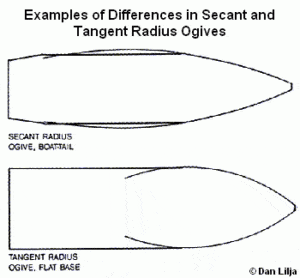
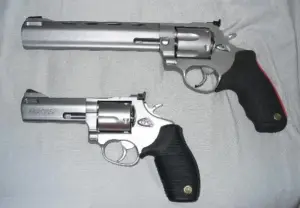









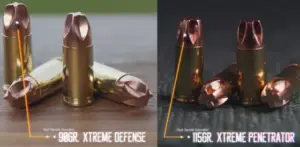















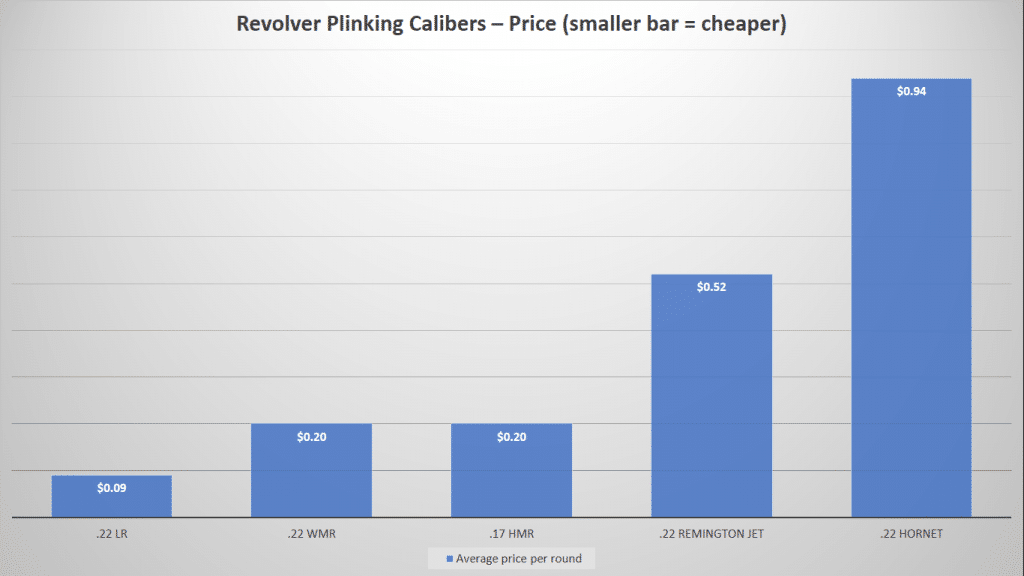



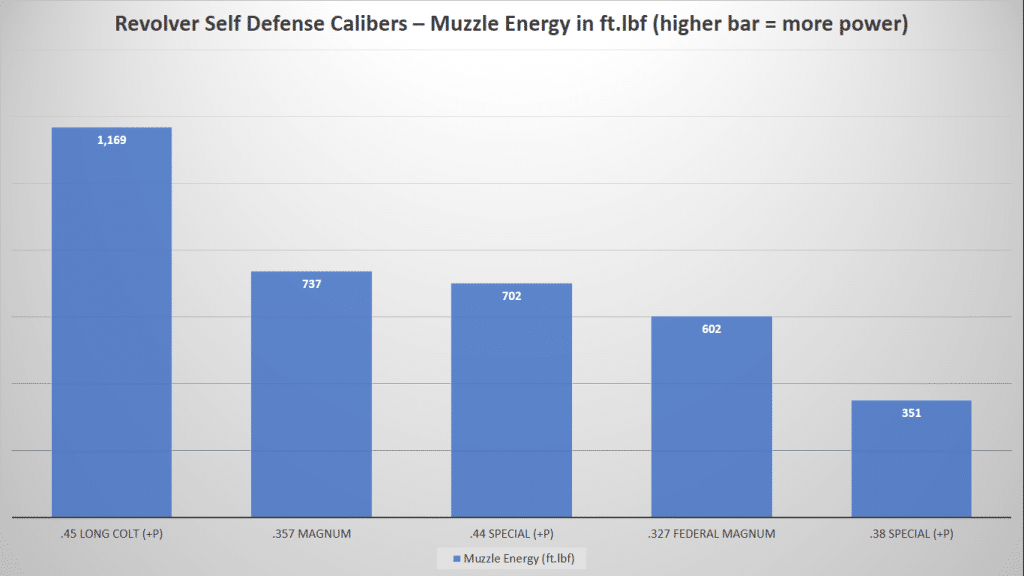


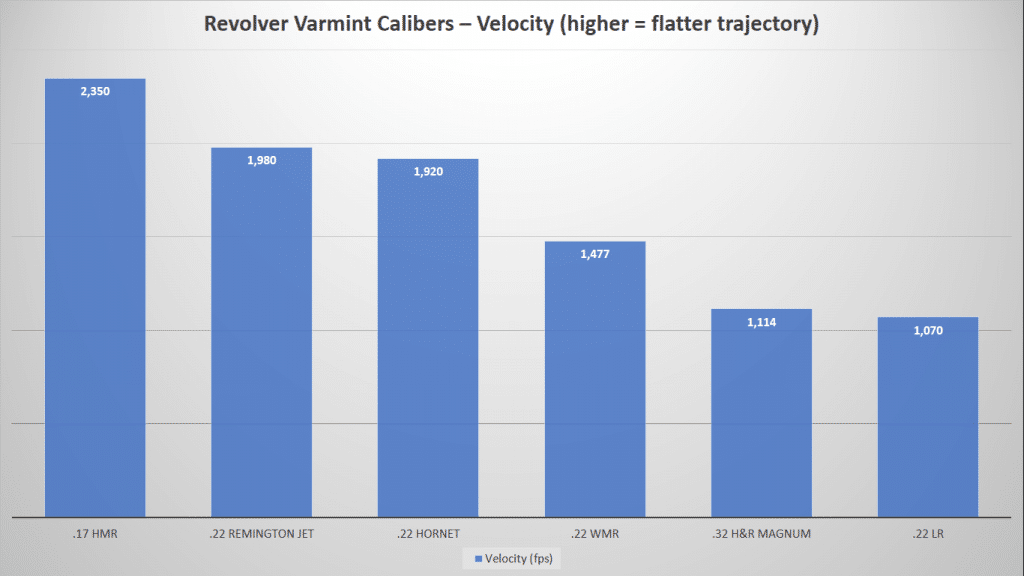
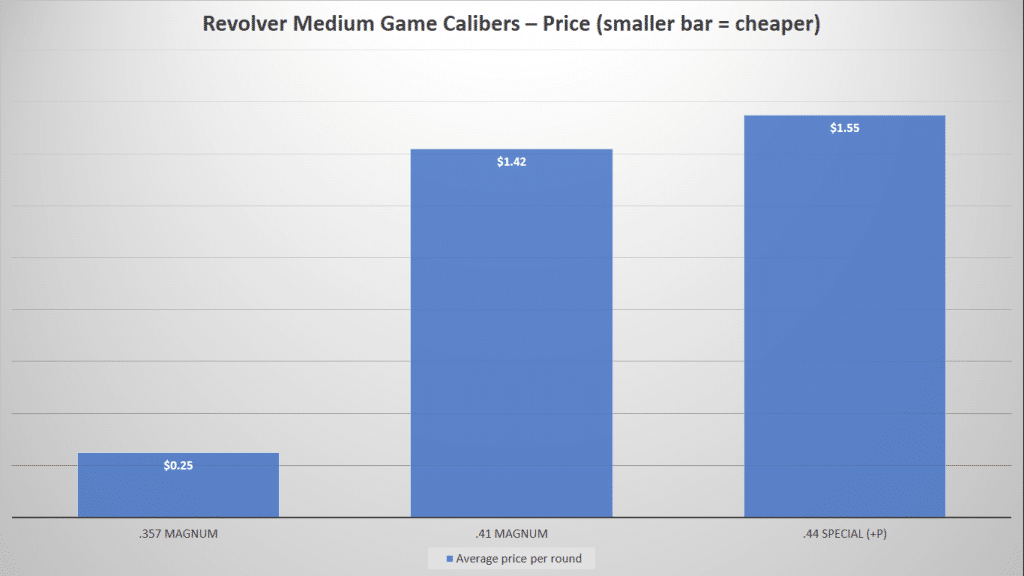
















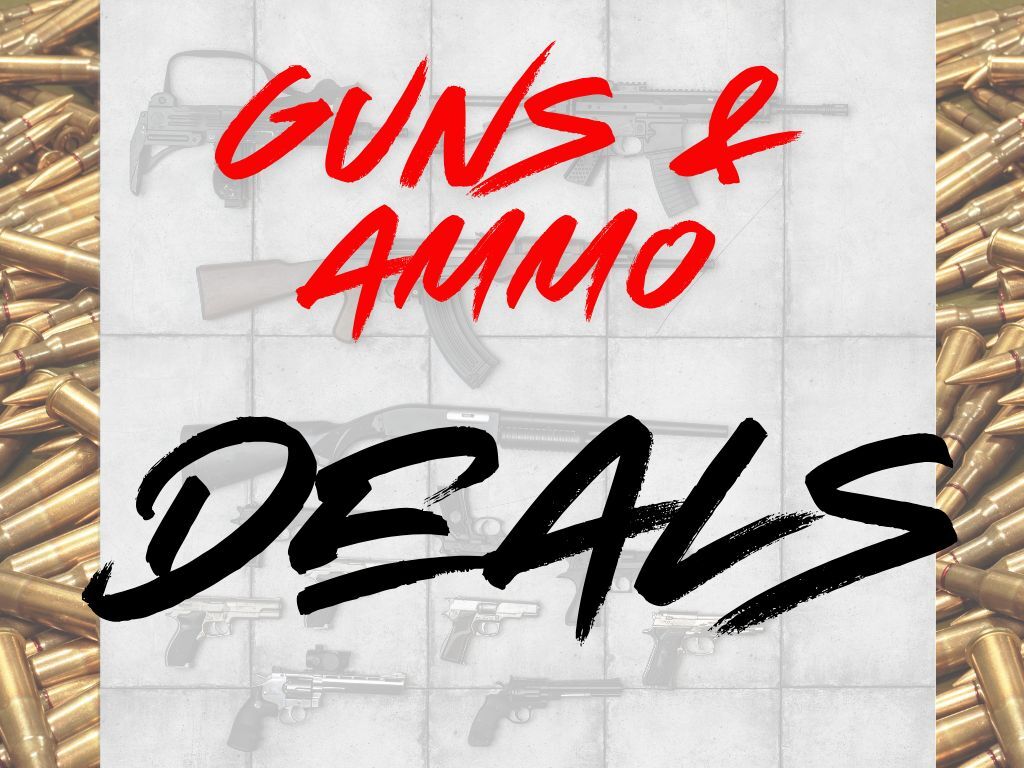
One Response
Overall, this was a very good article. Thanks for posting. However, I’m very surprised you label .22 as good for plinking and shooting little critters but not for self-defense. That’s shows me you aren’t very knowledgeable about how potent the .22 round can be. Let me ask you a couple questions and make sure you reply to me.
1) Most encounters happen with 4 yards. If you think the .22 is a wimpy round, can I get you to stand in front of me while I shoot it at you?
2) In that “oh shit” encounter, only those shooting with a 9mm are able to get around 20% of shots on target. Wanna know why? ITS BECAUSE THEY CANNOT HANDLES THE MUZZLE FLIP BRO!!!! However, how many round of .22 could be placed on target because they could handle the muzzle flip? And, if the goal is the STOP the threat, not necessarily ELIMINATE the threat, you can’t get a better caliber than a .22. Also, how many .22 head shots would you need to stop a threat? Hmmm, let me guess, ONE? There are several gelatin, drywall, clothing, tests on youtube showing the 22 is as good or better than the 9. THanks